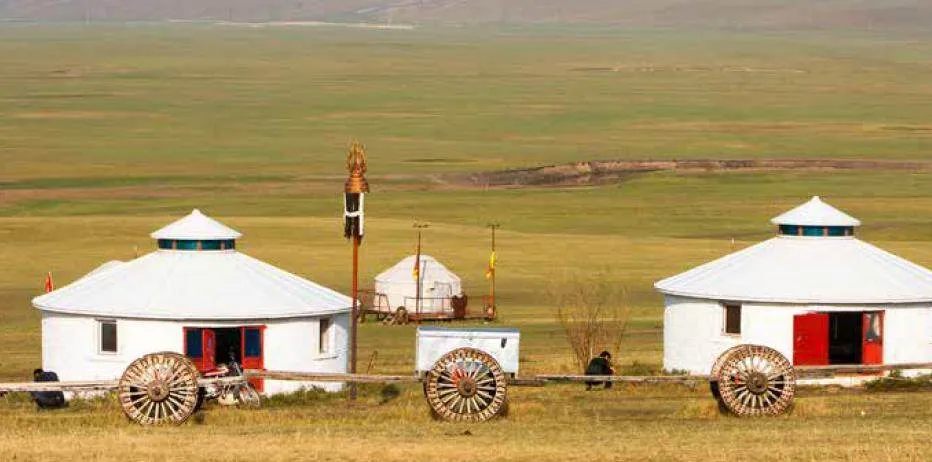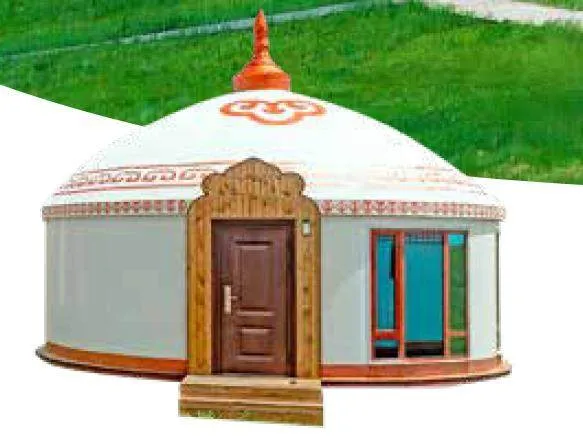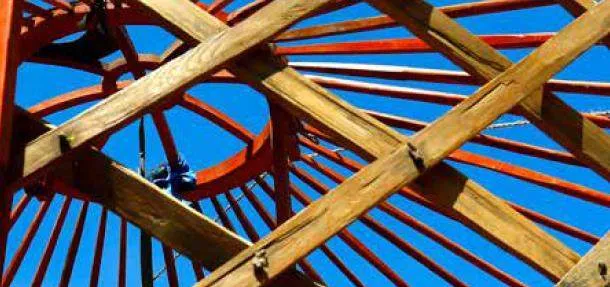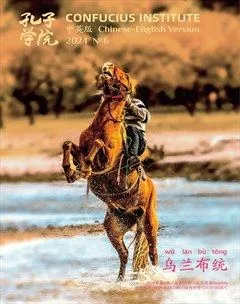蒙古包的变迁



蒙古包是内蒙古草原上一道独特的风景线,白色的毡布在金色的阳光下熠熠生辉,与周围的绿草构成了一幅绝美的草原画卷。蒙古包不仅是草原牧民遮风挡雨的居所,更是草原文化的独特象征,承载着岁月的沉淀和文化的厚重。
The yurt is a unique sight on the InnerMongolian grasslands, its white felt shimmering inthe golden sunlight and creating a stunning pastoralscene against the surrounding green grass. The yurtis not only a shelter from the wind and rain but alsoa distinctive symbol of pastoral culture with a longhistory.
蒙古包在古代被称作“穹庐”“毡包”或“毡帐”,在蒙古语中则表示“家”的意思。蒙古包的整体结构为球形,实用美观,简约却不简单。从实用性来看,球形结构能提供更大的居住空间,同时也有利于分散蒙古包所承受的外来压力。蒙古包的门朝向东南方,这沿袭了蒙古族认为旭日东升含吉祥寓意的传统,既方便牧民估算时间,又能避免强烈的冷风直入。
In ancient times, yurts were referred to asqionglu, zhanbao, or zhanzhang in Chinese. TheMongolian term that refers to yurt means “home.”The overall structure of a yurt is spherical, practicaland aesthetically pleasing, simple yet full-featured.From a practical standpoint, the spherical shapeprovides a larger living space and helps distributeexternal pressures. The door of the yurt facessoutheast, following the Mongolian tradition ofassociating the rising sun with good fortune, whichnot only helps herders estimate time but also preventsstrong cold winds from entering directly.
蒙古包白色的外观与蒙古族人民崇尚白色的传统息息相关。在蒙古族人民的眼中,白色寓意着美好、平安、纯洁。因此,在诸多颜色中,蒙古族人民选择白色作为蒙古包的外观颜色,毛毡上面再用各种刺绣图案加以点缀,使蒙古包兼具实用价值和美学价值。白色的蒙古包好似倒映在草原上的白云,与碧绿的草原、成群的牛羊构成了一幅美丽的图画。
The white exterior of the yurt is closely tied tothe Mongolian’s appreciation for the color white. Intheir view, white symbolizes beauty, safety, and purity.Thus, among various colors, the Mongolian peoplechose white for the yurt’s exterior, often adorned withintricate embroidery patterns, blending practicalitywith aesthetic value. From far away, the white yurtresembles clouds reflected on the grassland, forminga beautiful picture alongside thelush greenery and herds of cattleand sheep.
蒙古族人民在建造蒙古包时,多采用就地取材的方式,只对原材料做一些简单的加工。这样,既不会过多消耗材料,也减轻了对劳动力的需求。这种就地取材的绿色设计理念彰显了蒙古族人民敬畏自然、适应自然的生活智慧。
When building a yurt, the Mongolian peopletypically use locally sourced materials with minimalprocessing. This approach not only conservesresources but also reduces labor demands. Thisenvironmentally conscious approach of designreflects the Mongolian people’s respect for andadaptability to nature.
传统的蒙古包在搭建时,选址十分关键,而搭建的过程则相对简单。在搭建蒙古包之前,牧民会选择一个地势平坦、水草丰美的地方,根据所需要蒙古包的大小先画一个圆形,以便确定蒙古包的位置。位置固定后,牧民便会在圆内找到蒙古包的中心点,并固定一个中心杆,在圆的最外侧确定门窗的位置。做完这些之后,牧民就可以开始搭建蒙古包的框架了。
Choosing the right site for a traditional yurt iscrucial, though the construction process is relativelystraightforward. Herders would select a flat arearich in water and grass, and mark a circular outlinebased on the desired size of the yurt to determine itslocation. Once the location is decided, they find thecenter point within the circle and secure a centralpole, and determine the locations for doors andwindows at the outer edge. Aftercompleting these steps, they canbegin constructing the yurt’sframe.
蒙古包的框架一般为木架结构,以便起到支撑作用。框架由“哈那”“乌尼”“陶脑”三部分组成。首先需要搭建的是蒙古包的外围——哈那。哈那是蒙古包的围壁,主要由规格统一的红柳木条构成,红柳木条交叉形成菱形网状结构,再由毛绳连接固定好。哈那不仅能起到支撑作用,同时决定着蒙古包的大小。哈那固定好后,通过乌尼将哈那与陶脑连接起来。乌尼的长度和角度决定着蒙古包的高度。陶脑是蒙古包的天窗,主要由檀木或榆木制作而成,可以通风采光。当你在草原地区听到“太阳照到陶脑圈了”,说明太阳升起来了;如果牧民说“太阳照到乌尼中间了”,说明该将一早出去放羊的人换回来了。因此,蒙古族人也将此时的太阳称为“迎接羊倌的太阳”。
The frame is typically made of wood to providestructural support and consists of three main parts:hana, uni and tonao. The first part to be constructed isthe hana, meaning the outer wall, made of uniformlysized red willow branches, which are woven intoa diamond-shaped lattice and secured with ropes.The hana not only supports the structure but alsodetermines its size. Once the hana is fixed, the uniconnects it to the tonao. The length and angle of theuni determine the yurt’s height. The tonao serves asa skylight, made primarily from sandalwood or elm,allowing for ventilation and light. In the grasslands,when someone says, “The sun has reached the tonaoring,” it means the sun has risen; if they say, “The sunhas reached the middle of the uni,” it indicates that it’stime to bring back those who went out to herd sheep.Thus, the Mongolian people also refer to the sun atthis time as “the sun welcoming the herders.”
蒙古包的框架固定好后,接下来需要给蒙古包披上“外衣”——苫毡。苫毡是覆盖在蒙古包外围的毛毡,主要由羊毛擀制而成,具有防风保暖的重要作用。根据所处位置的不同,可以将苫毡分为盖毡、顶毡、围毡和地毡四种。牧民根据气温的变化来增减毛毡,气温降低时增加毛毡用来保暖;气温回暖时减少毛毡,以便通风。苫毡固定好后,便是安装蒙古包的烟囱,以起到排烟的作用。至此,一个蒙古包就搭建好了。蒙古包的内部装饰一般根据主人的喜好进行设计。
After the frame is complete, the yurt is coveredwith shanzhan, a felt layer made from sheep woolthat plays a vital role in wind proofing and insulation.Depending on the actual place of installment,shanzhan can be divided into four types: coveringfelt, top felt, wall felt, and ground felt. Herders add orremove layers of felt based on temperature changes,adding more for warmth in colder weather andreducing them for ventilation in warmer conditions.Once the shanzhan is secured, the chimney isinstalled for smoke ventilation. At this point, the yurtis fully assembled, and the interior decorations aredesigned according to the owner’s preferences.
草原上气候干旱,各地降水不均,不同地区牧草的生长与品质参差不齐,因此,牧民们过着逐水而居的生活。蒙古包搭建和拆卸都比较方便,往往只需要几匹马、几头骆驼就可以实现自由移动,相比于其他类型的建筑,更适合游牧生活。因此,蒙古包成了草原上蒙古族人民的得力伙伴。
The grassland climate is dry with unevenprecipitation, and the growing season and quality ofpasture vary across regions, which has led herdersto live a water-centric lifestyle. Yurts are easy to setup and dismantle, often requiring just a few horsesor camels for moving, making them more suited fora nomadic way of life than other types of buildings.Consequently, yurts have become invaluablecompanions for the nomadic Mongolian people.
如今,蒙古包以其美丽的外形和浓厚的文化内涵,逐渐成为草原上最具代表性的文化符号之一,每年吸引着无数的海内外游客前来体验。为了克服传统蒙古包的缺点,许多年轻的牧民纷纷投身于现代蒙古包的研究。其中最具代表性的便是低能耗式蒙古包和装配式蒙古包。它们不仅实现了现代科技与蒙古族文化的完美融合,冬暖夏凉,还大大提高了蒙古包的环保性、经济性、实用性和美观性。
Today, yurts, with their beautiful design and rich cultural connotations, are becoming one of themost iconic cultural symbols of the grasslands, attracting countless tourists from near and far each year.To overcome the shortcomings of traditional yurts, many young herders are dedicated to researchingmodern yurts, including low-energy and prefabricated models. These innovations not only merge moderntechnology with Mongolian culture, providing warmth in winter and coolness in summer, but alsosignificantly enhance the yurt’s environmental friendliness, economy, practicality, and aesthetic appeal.
蒙古包是游牧民族数千年生活智慧的结晶,陪伴牧民们度过了漫长的岁月,是游牧民族生活中不可或缺的一部分。在广袤无垠的大草原上,蒙古包像一列列移动的“白色列车”,满载着牧民的希望,驶向幸福,驶向未来。
The yurt is the culmination of thousands of years of nomadic wisdom, accompanying herders throughlong years and forming an indispensable part of their lives. Across the vast grasslands, yurts resemble a fleet ofmoving “white trains,” carrying the hopes of herders toward happiness and the future.

